Sioshansi F.P. Smart Grid: Integrating Renewable, Distributed & Efficient Energy
Подождите немного. Документ загружается.

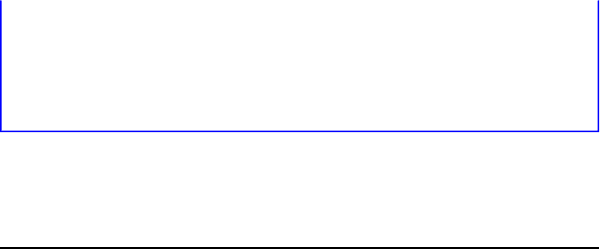
Projected global greenhouse gas emissions under 550 ppm, 450 ppm, and IEA
“BLUE Map” scenarios. The 550 ppm and 450 ppm scenarios include emission
reductions from forestry and agriculture, whereas the IEA “BLUE Map” only
includes energy-related emission reductions.
Source: Commonwealth of Australia [21]; IEA [19]
Results and Discussion
Modeling Results
In Figure 7.7A a plot is provided for the BAU case with a
20% cap under the Case A scenario previously described. In
Figure 7.7B the BAU case for a 50% cap under the Case D
scenario is displayed for comparison. Both figures clearly
show that global electricity demand is expected to grow
significantly, increasing two-and-a-half times by 2050. In
these figures coal represents all brown and black coal sources
with and without carbon capture and sequestration (CCS).
Gas represents both open cycle and combined cycle turbines
with and without CCS. Non-intermittent renewable
generation, NI RG, includes biomass, hot fractured rocks,
conventional geothermal, and hydroelectric. RG represents
intermittent renewable generation sources including
large-scale PV and solar thermal, wind, wave, and ocean/tidal
current. Small-scale rooftop PV is not included here as it is
captured within DG, which represents small-scale
technologies such as PV, CHP, and fuel cells.
391
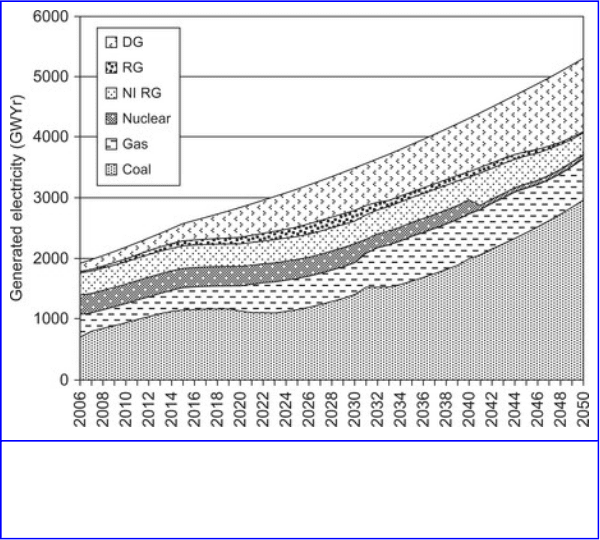
Figure 7.7A
Case A: Global technology mix assuming business as usual.
392
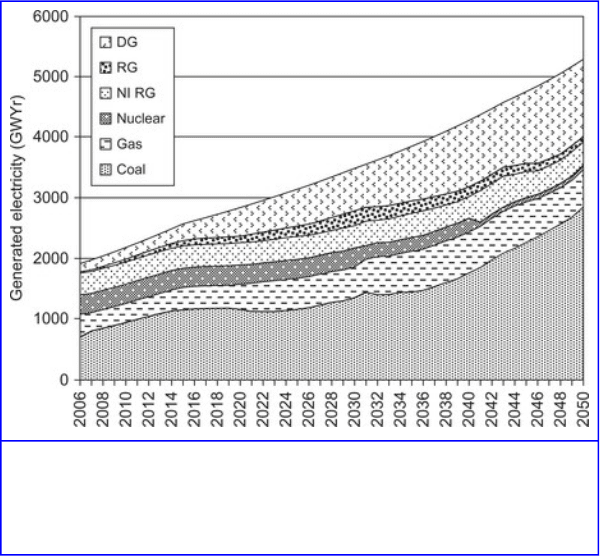
Figure 7.7B
Case D: Global technology mix assuming business as usual.
Source: CSIRO
Figure 7.7A and Figure 7.7B show that the absence of a
carbon price has not prevented the uptake of solar-based
renewable technologies and CHP. All of these technologies
receive some form of government support in the model, such
as feed-in tariffs or heat credit. Solar thermal has the
additional advantage of providing some peaking power. These
technologies, with the exception of CHP, have high learning
rates as described in Table 7.1; therefore by increasing their
cumulative capacity their capital costs fall over time. Black
coal pulverized fuel plant continues generating beyond 2050,
and black coal combined cycle, with its higher efficiency,
absorbs the growing demand for electricity. Under this
393

scenario very little CCS technology is developed. This is also
the case for ocean energies, biomass, and geothermal plant.
The modeling results indicate that the total amount of
intermittent generation does not necessarily reach the cap in
all three regions in the model, but it does reach the cap in at
least one. This level of detail is not captured in these figures,
which simply present the total worldwide generation.
However, this means that even under a BAU case there are
financial benefits to be gained by using smart grids, assuming
they increase the amount of intermittent generation that can
integrated into the grid.
For comparative purposes, results from the IEA [19]
projections for the year 2050 for uptake of various electricity
generation technologies under their baseline scenario are also
presented. The results are shown in Table 7.3. It is not
apparent if any intermittent constraints have been made by the
IEA in their modeling, and therefore they are compared with
the range of outputs in the modeling presented here.
Table 7.3
BAU Cases A, Assuming a 20% Maximum Intermittency and D, Assuming a 50%
Maximum Intermittency, and IEA Baseline Scenario Projected Share of Electricity
Generation Technologies in the Year 2050
BAU Case A (%
Share)
BAU Case D (%
Share)
IEA Baseline (%
Share)
Coal 55 54 41
Gas 13 12 14
Nuclear 1 1 10
Non-intermittent
renewable
7 7 15
Intermittent
renewable
1 2 6
Source: CSIRO.
394

Distributed
generation
23 24 14
Source: CSIRO.
Major differences between the modeling presented here and
the IEA results lie in the share of coal to nuclear and the share
of renewable generation, both intermittent and
non-intermittent, and DG. The differences between coal and
nuclear arise because of two issues:
• The first is that this modeling uses a flat price for coal and
a cost curve for uranium, so that the more uranium is used
the more expensive it becomes.
• Second, this modeling has a higher capital cost for
nuclear than the IEA [19], which makes nuclear a less
attractive option in GALLM. The IEA nuclear costs are
primarily U.S. based while the figures in this analysis are
global, including European costs informed by recent data
from manufacturers. Furthermore, these baseline cases
place no cost on greenhouse gas emissions; therefore there
is no need to build zero-emission technologies unless they
are economic.
The IEA results show a bigger share of generation from
non-intermittent renewable generation, most likely due to
constraints in GALLM, particularly for hydroelectric
generation. The IEA's biomass component includes waste,
which is modeled here as DG since this can encompass
bagasse and other locally produced biomass waste that is used
as fuel close to where it has been harvested. GALLM predicts
more DG mainly because of rooftop PV, which has a high
learning rate compared to other technologies, and its capital
cost becomes quite low in time, reaching 1400 $AU/kW by
2050. In this modeling there are no limits on the amount of
395
rooftop PV that can be constructed, aside from the cap on
intermittent sources. It is worth noting, however, that an
earlier study [22] in Australia showed that PV installation was
economically constrained rather than physically constrained
by available roof space, assuming slightly less than one
quarter of available rooftop space was used.
In Figure 7.8A a plot is provided for the 450 ppm case with a
20% cap (Case A). In Figure 7.8B the 450 ppm case for a
50% cap (Case D) is displayed for contrast. These results
show that for a grid constrained by 20% intermittent
resources, large centralized low-emission plant such as coal
with CCS, shown as Coal, and nuclear play a strong role,
while gas turbines provide a large amount of the generation
mix because of its cheap price and its use in peaking
operation. When the constraints on intermittency are relaxed,
the strong price of carbon results in large amounts of rooftop
PV, in the DG set, and solar thermal and wind, in the RG set,
being economically deployed over the period to 2050. In this
case nuclear also plays a strong role, while gas and coal with
CCS, shown as Coal, are deployed at much lower rates than
in the more constrained intermittency case.
396
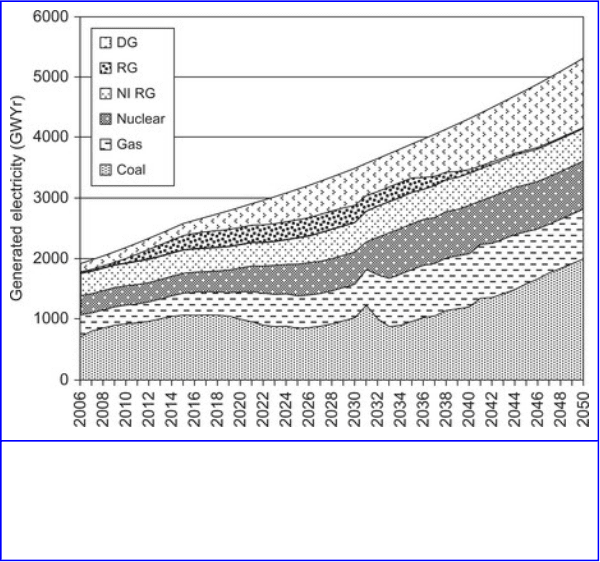
Figure 7.8A
Global technology mix under a 450 ppm case with a 20% cap on intermittent
sources.
397
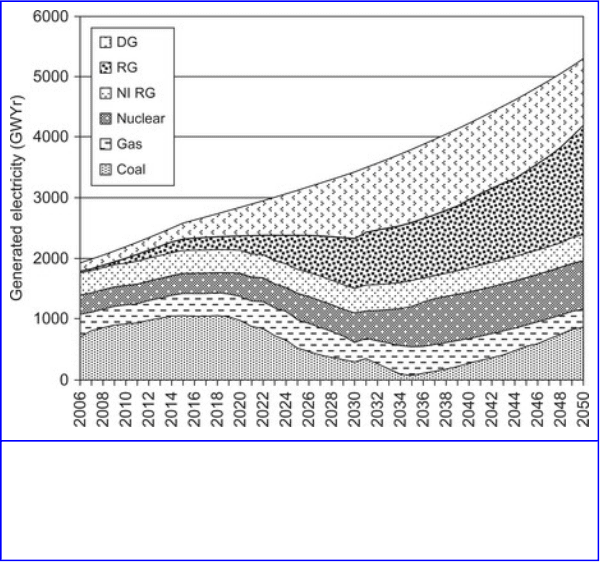
Figure 7.8B
Global technology mix under a 450 ppm case with a 50% cap on intermittent
sources.
For comparison, Table 7.4 shows the projected share of
electricity generation technologies in the year 2050 under the
450 ppm case compared with the IEA [19]“Blue Map”
scenario, which has also been designed to achieve 450 ppm.
In Case A where intermittent sources are limited to a cap of
20%, the modeling shows a 21% share in DG. In this case
little large-scale intermittent renewable generation is
predicted. When the intermittency constraint is relaxed in
Case D, the DG and large-scale intermittent renewable
technologies increase to a 54% share. In contrast, the IEA in
their predictions shows a 34% total for intermittent
renewables. The technologies that have increased the most
due to the relaxing of the intermittent constraint are solar PV,
398
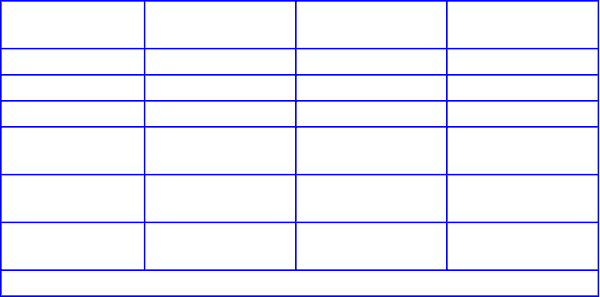
solar thermal, and wind. In the IEA's case, the renewable
technologies that have increased their share the most
compared to the BAU case are wind and solar. Geothermal
triples its share but it is starting from a lower BAU generation
capacity.
Table 7.4
450 ppm Cases A and D and IEA BLUE Map Scenario Projected Share of
Electricity Generation Technologies in the Year 2050
450 ppm Case A
(% Share)
450 ppm Case D
(% Share)
IEA BLUE Map
(% Share)
Coal 37 16 12
Gas 16 6 7
Nuclear 15 15 24
Non-intermittent
renewable
10 8 23
Intermittent
renewable
1 34 19
Distributed
generation
21 20 15
Source: CSIRO.
The differences between Case A and the IEA BLUE Map are
again in the shares of nuclear vs. coal and of renewable
generation, both intermittent and non-intermittent, vs. DG.
However, there are fewer differences between Case D and the
BLUE Map scenario. Case D has more intermittent renewable
generation than non-intermittent, whereas the IEA has more
non-intermittent generation. The GALLM model also predicts
more than double the amount of intermittent renewable
generation compared to nuclear, whereas the IEA has more
nuclear than intermittent renewable generation.
These differences reflect the generous 50% intermittent
constraint, which is allowing more large-scale intermittent
399
renewable technologies with high learning rates, such as solar
thermal, wave, and wind, into the market. The more these
technologies are deployed, the lower their capital costs
become due to assumptions on learning rates. The IEA does
not state the limits used in their modeling but the results
suggest they may use a cap lower than 50% on intermittent
technologies, yet not as low as 20% since both intermittent
renewable generation and DG contain intermittent
technologies and the total of these is 34%.
It is worth reiterating that the modeling simply examines the
savings that might be achieved by allowing an increase in
intermittent generation—mostly attributed to the presence of
smart-grid-enabling infrastructure. It does not specify how
this may be achieved, only the savings that might be realized
through their use. There are many possible ways in which
intermittent generation may be better integrated into
electricity networks including the use of storage, better
management of demand through increased consumer
awareness and appliance automation, and better forecasting of
demand and supply for instance as discussed below and
covered in more detail in other chapters of this book.
The modeling displayed above shows that in later years,
traditional peaking plant such as gas turbines become less
prevalent and slower reacting plant such as nuclear begin to
dominate large centralized facilities. In simple terms in
current electrical networks the balance between supply and
demand is provided by these large plant, which receive
appropriate signals from a central control to ramp their supply
up or down as required. Ongoing developments in
transmission and centralized dispatch fit within the wider
smart grid paradigm, and it will need to continue to evolve to
400
